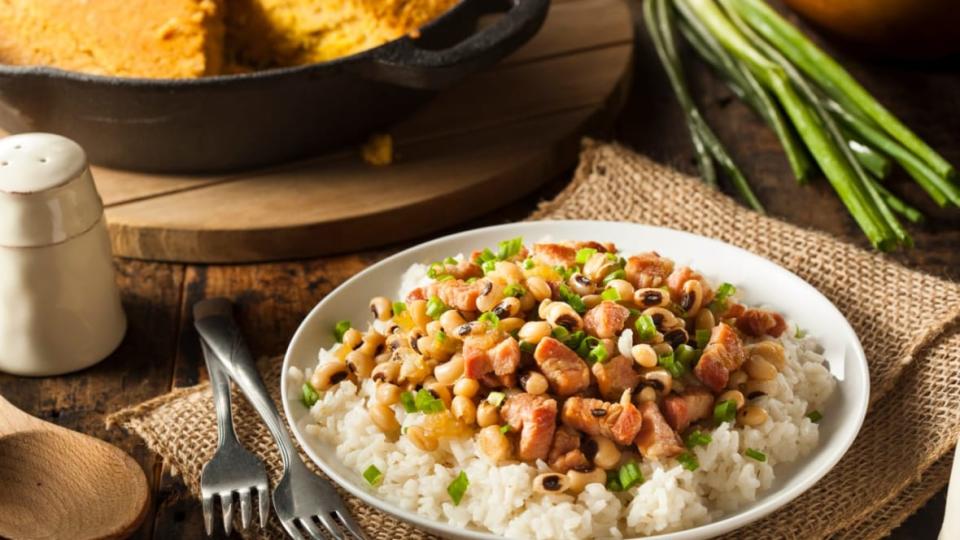Taste tradition: Why we eat black-eyed peas, greens, and cornbread on New Year’s Eve
Ever wondered why black-eyed peas and greens are a must-have in Black households celebrating the new year? TheGrio breaks it down for you.
There are all sorts of traditions that ring in the new year, but I can’t think of one tastier than the custom of eating black-eyed peas, collard greens, and cornbread on Jan. 1.
Those dishes encompass the centerpiece of the traditional New Year’s meal for Black families, recipes handed down for hundreds of years.

Black-eyed peas originated in West Africa, where they’re known as “cowpeas.” In some African religions, worshipers offered the peas to deities to please them. According to Cuisine Noir, some also believed the peas could help ward off evil.
Enslaved West Africans brought cowpeas to the West Indies by 1674, according to the Library of Congress. The peas then made their way to the United States, where they were initially used to feed livestock. Several texts claim that during the Civil War, General William Tecumseh Sherman’s Union Army plundered crops throughout the South but ignored the black-eyed peas, ostensibly due to their lowly reputation as livestock food. With crops dwindling, enslaved people ate the peas left behind, eventually cementing their place in the soul food tradition.
The meal also has a direct tie to Watch Night, also known as Freedom’s Eve.
On Dec. 31, 1862, free and enslaved Black people gathered — some publicly, some quietly — to ring in the new year and await news that the Emancipation Proclamation, signed on Sept. 22, 1862, would take effect. On Jan. 1, they gathered for a meal of collard greens, black-eyed peas, and rice, a dish now known as “Hoppin’ John,” according to the National Museum of African American History and Culture. The museum notes that other dishes, including cornbread, rounded out the meal.
The peas and greens each have significant meaning, with the peas depicting luck and the greens the color of money. Cornbread is, of course, the color of gold. Together, they represent the promise of good fortune and prosperity.
And there’s this fun fact: Black-eyed peas really aren’t peas; they’re legumes, which refer to the entire plant (leaves, stem, and pods) from the Fabaceae family.
Black-eyed peas, greens and cornbread are clearly a tasty cultural staple. So how do you best make them?
Black-Eyed Peas
You can make the peas in one of two ways or go for the easiest possible method.
Stovetop
One pound of Black-eyed peas takes about 90 minutes to soften. Put them in a bowl, rinse thoroughly, and then add the peas to a pot of boiling water. Reduce the water to a simmer and cook until the beans soften. Presto — that’s it! I soak my peas overnight because I find it makes them softer. However, you’ll find lots of recipes that avoid the soaking step.
Slow Cooker
You can also put the beans in a slow cooker for six to eight hours. Put them in when you go to bed, and when you wake up, they’ll be ready. Easy. One pound of dry beans should yield about 5 1/2 cups of cooked beans, so you’ll have plenty extra. If that’s too much and you think they’ll go to waste, you can use the easiest possible method.
Use Canned or Frozen Peas
On the one hand, there’s nothing wrong with canned black-eyed peas. They’re cheap for a 15-ounce can. Just open, pour, and you’re done. I prefer dry beans because, as you’ll see in the below recipe, I like to cook them down, so they absorb as much flavor as possible from the other ingredients in the pot. If you want to make fresh beans but not cook the whole bag, this handy calculator says 4 1/2 ounces of dried, uncooked peas equals one can of 15-ounce peas.
Cans or even frozen black-eyed peas are fine if you’re just making the peas. But they don’t work well if you want to cook to impress and make Hoppin’ John.
As with any recipe, Hoppin’ John can be made in several different variations. The dish calls for pork, generally a ham hock or slab of bacon, though others use pork sausage or country ham. You can use whatever you prefer to infuse similar flavor without pork, including smoked turkey legs, wings, or necks, or chicken or turkey andouille sausage. The Obama White House archive has another Hoppin’ John recipe that incorporates the collard greens.
By the way, there’s no consensus on where the term “Hoppin’ John” originated. According to History.com, it could have been named for an old, hobbled man who sold peas and rice in Charleston, South Carolina. Or, enslaved people may have named the dish after the children who excitedly hopped around the table when they knew it would be served. Regardless of how it got its name, it’s good.
Hoppin’ John
2 tbsp. of canola oil
1 cup each of chopped onion, celery, and bell pepper (not green because it will make the dish bitter)
Pork or smoked protein of your choice (I use a ham hock)
3 cloves of minced garlic
4 cups of low-sodium chicken stock or water
1 bay leaf
6 oz. of dried black-eyed peas (will yield about 2 1/2 cups of cooked peas)
1 tbsp. of salt
1 tbsp. of butter
4 cups of water
2 cups of rice
Salt and pepper to taste
Add two tablespoons of canola oil to a Dutch oven or heavy pot. Add the onion, celery, bell pepper, and pork or protein of your choice to the pot over medium heat. Stir occasionally to make sure the vegetables don’t burn, and cook until they start to soften; about five minutes. Add the garlic and stir until fragrant, about 30 seconds.
Add 1/4 cup of the chicken stock to deglaze the pan, then add the remaining stock. Bring the liquid to a low simmer, then add the bay leaf and the dried peas. Cover, occasionally checking to make sure the liquid covers the peas. Add water if you need it. The peas should soften in about 90 minutes.
Meanwhile, make the rice: Add one tablespoon of salt and one tablespoon of butter to four cups of water and bring to a boil. Add two cups of rice, reduce to a simmer, and cover for 15 minutes. After 15 minutes, remove from the heat and let sit for another 15 minutes.
Once the peas soften, add salt and pepper to taste. If the mixture is too soupy, pour out some of the water. I like to make a roux and thicken the mixture, so I have a little gravy, which isn’t part of a traditional Hoppin’ John, but I like it.
Ladle the Hoppin’ John over the rice. Makes four large servings.
Greens
Any greens will do, but I love collards and have an easy, straightforward recipe. You’ll need a very large pot as well as:
2 tbsp. salt
2 bunches of greens, which will yield 3 to 4 pounds after trimming
2 ham hocks (or the smoked protein of your choice)
5 to 6 cups of chicken broth or water (chicken broth is far better)
2 tbsp. of Frank’s® RedHot sauce
2 tbsp. of white vinegar
2 cloves of garlic, whole
Salt and pepper to taste
(The cooking is easy. The prep is a bit of a chore.)
Fill your kitchen sink with water, add two tablespoons of salt, and soak both bunches of greens for at least 20 minutes. You’ll need to swish the greens in the water to ensure you loosen and remove any dirt that may be caught in the leaves.
Take the leaves out of the water and pat dry. Remove the stems from the greens; I pull them apart, but you can also fold the greens in half and use a knife to remove the stem.
Cut the greens. I roll up the leaf (it doesn’t matter if you start with the long or short end) and chop it. You don’t want the pieces too small because the greens should have a little size to them.
Heat a large pot over medium heat. Add the ham hocks and cook for about three minutes, stirring regularly. Add the chicken stock, hot sauce, vinegar and garlic, and bring to a boil. Add the greens, reduce to a simmer, and cook for at least 90 minutes or until the greens become tender. Toward the end of the cooking process, taste the broth and adjust the flavors by adding salt and pepper and additional hot sauce and vinegar. I love vinegar in my greens but I’ve adjusted the amount to suit a wider audience.
Cornbread
TheGrio recently looked at three different cornbread options — a traditional dense cornbread, a sweet cake-like cornbread, and a kicked-up version with jalapeño and bacon. To pair with black-eyed peas and greens, I tend to make the sweet version. Here’s the recipe:
1/2 cup of cornmeal
1 1/2 cups of flour
1 cup of sugar
3 tablespoons of baking powder
1/2 cup of melted margarine
2 eggs
1 cup of whole milk
2 tbsp. of melted margarine
Preheat the oven to 400 degrees. Put the dry ingredients in a bowl and mix the wet ingredients in another. Combined the two and mix until smooth. Pour into a 12-inch cast iron skillet and bake for 25 to 30 minutes until the top is golden brown. Pour the two tablespoons of melted margarine over the hot cornbread.

Ray Marcano is a veteran journalist who loves to cook and write about food. He’s the former national president of the Society of Professional Journalists, a two-time Pulitzer juror, and a Fulbright Fellow.
TheGrio is FREE on your TV via Apple TV, Amazon Fire, Roku, and Android TV. TheGrio’s Black Podcast Network is free too. Download theGrio mobile apps today! Listen to ‘Writing Black‘ with Maiysha Kai.
The post Taste tradition: Why we eat black-eyed peas, greens, and cornbread on New Year’s Eve appeared first on TheGrio.

